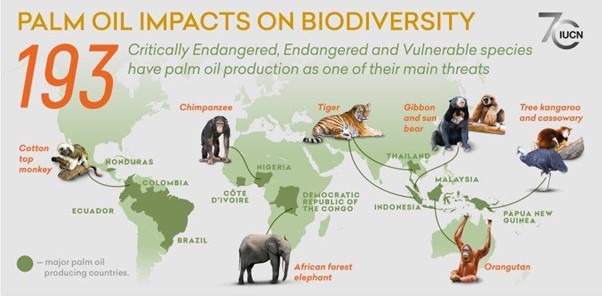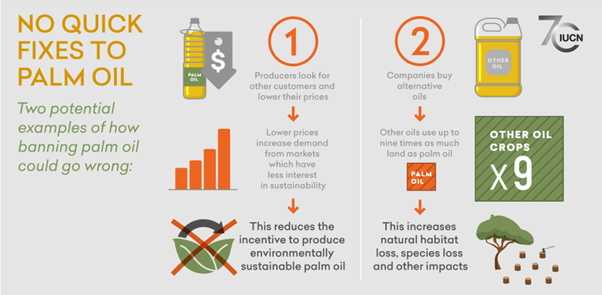Biodiversity & Palm Oil
Impact
Biodiversity, the amazing and enormous variety of animal and plant life and the biomes and ecosystems in which they are found around the world, is increasingly impacted by human activities including conversion of wild spaces for the production of commodities, pollution, and actions contributing to climate change.
The production of palm oil has been associated with biodiversity loss and it is true that conventionally-produced palm oil has had devastating impacts not only on iconic species such as orangutans and tigers and their habitats, but also many more species, big and small. By adopting sustainable practices, the palm oil value chain can actually help protect these species.

How does unsustainable palm oil threaten biodiversity?
One of the key drivers to loss of biodiversity is loss of habitat, particularly forest habitat. While some oil palm plantations were originally established by replacing less-productive rubber or coconut plantations for example, many more have been developed at the cost of the hugely biodiverse tropical rainforest ecosystems in places like Indonesia and Malaysia.
How can sustainable palm oil protect biodiversity?
Because oil palm is cultivated in the tropical regions of the planet, where terrestrial biodiversity is most abundant, many species share the same landscapes. Regions historically or currently dominated by rainforests provide ideal climatic conditions for growing oil palm. Under the rules of RSPO certification, these forests must not be cleared by growers and must instead be protected. High Conservation Value (HCV) and High Carbon Stock (HCS) areas must be conserved or enhanced. Additionally, growers are required to protect rare, threatened or endangered species encountered in their concession areas.
Responsible growers have demonstrated that the biodiversity which occurs in and around their concession areas can thrive, not only as a result of not disturbing the species or their habitat, but also by taking direct action such as developing wildlife corridors, working with communities to combat poaching, and educating their workforce on the need to protect wildlife.
Would switching to alternative oils help protect biodiversity?
Those concerned about the threats to biodiversity from palm oil may be inclined to think that avoiding palm by switching to alternative oils would solve the problem. Researchers have looked into this idea, considering rising global demands for edible oils and what impacts alternatives would have if they were to replace palm oil. They have concluded that replacing palm oil is no solution, especially when it comes to protecting biodiversity.
One reason for this is because palm oil is the highest-yielding oil seed crop by a wide margin over the alternatives. If palm oil were to be replaced by the lower-yielding crop, up to nine times as much land would be needed. Today, palm oil represents 35% of the consumption of all vegetable oils globally, but uses only 10% of the land allocated for the production of vegetable oils. Shifting to another oil in another region results in shifting the deforestation and biodiversity loss elsewhere and potentially increasing it due to the greater area of land needed. The best alternative to palm oil? Sustainable palm oil!

Shared Responsibility: Everyone can play a part!
It’s not just the growers of oil palm who can make a positive difference for wildlife. Stakeholders all along the supply chain can support biodiversity by supporting sustainable palm oil, thereby rewarding the growers who are doing things right and incentivising more to come on board. Supporting smallholders is also essential; smallholders account for 40% of global production of palm oil, and unless enabled to be part of the journey towards sustainability can represent a huge collective threat to biodiversity. Consumers can play their part as well by choosing products using sustainable palm oil and communicating to brands and retailers that they expect that the products they buy are not contributing to biodiversity loss.